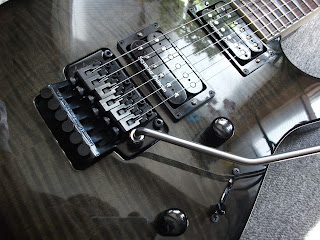A couple years back, I saw a blog about someone making a pedal board out of an old briefcase, and I decided to make one for myself. I scored the case from the local thrift store for $3.99, and went to work! This is what I came up with. The board has a two-level bottom made from 3/8" plywood, with a slightly lower area on the right to accommodate a wah-wah pedal. All of the wiring connecting the pedals runs neatly underneath the bottom layer, and the entire rig runs on a one-spot power adapter.
Although these are no longer all the same pedals I have on the board, they are, from left to right:
(top row) MXR Smart Gate, MXR Micro Amp, MXR Phase 90
(bottom row) Ibanez DL10 Digital Delay, Ibanez CS9 Stereo Chorus, Ibanez TS9 Tube Screamer
Although these are no longer all the same pedals I have on the board, they are, from left to right:
(top row) MXR Smart Gate, MXR Micro Amp, MXR Phase 90
(bottom row) Ibanez DL10 Digital Delay, Ibanez CS9 Stereo Chorus, Ibanez TS9 Tube Screamer
(far right) Modified Jim Dunlop GCB95 Crybaby Wah
I have since painted the bottom black to give the whole thing a cleaner look; I will post pics as soon as I have them. Thanks for looking, and feel free to contact me for any advice if you're trying to make one for yourself!
I have since painted the bottom black to give the whole thing a cleaner look; I will post pics as soon as I have them. Thanks for looking, and feel free to contact me for any advice if you're trying to make one for yourself!

 what th
what th













